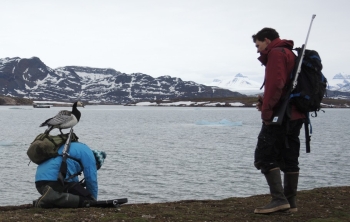From historical data to a prediction of the future for geese on arctic tundra?

This project studies the dynamics in the structure of an Arctic terrestrial food web and the genetic structure of a population of geese. Geese play a central role in this food web. Historical patterns of habitat distribution will be analysed to recognize the effect of local and global anthropogenic drivers of change. Observations over a time-series of 23 years on three trophic levels with details on food availability, diet selection, intake rate, plant-animal interaction, habitat use, reproductive success and timing of marked individuals (plants, geese and foxes) are combined with predator abundance, predation pressure and disturbance into a spatial model of resource utilisation, habitat distribution and population dynamics. Information on the genetic structure of the barnacle goose population will provide novel insight in contemporary patterns of divergence, population size and gene flow. While studying species-specific plant-animal interaction and immunological parameters we hope to understand historical changes in species distribution. All elements combined should enable the prediction of future scenarios of anthropogenic impact on species interaction within the food web.
PhD: Margje de Jong
| Last modified: | 03 May 2021 4.20 p.m. |
